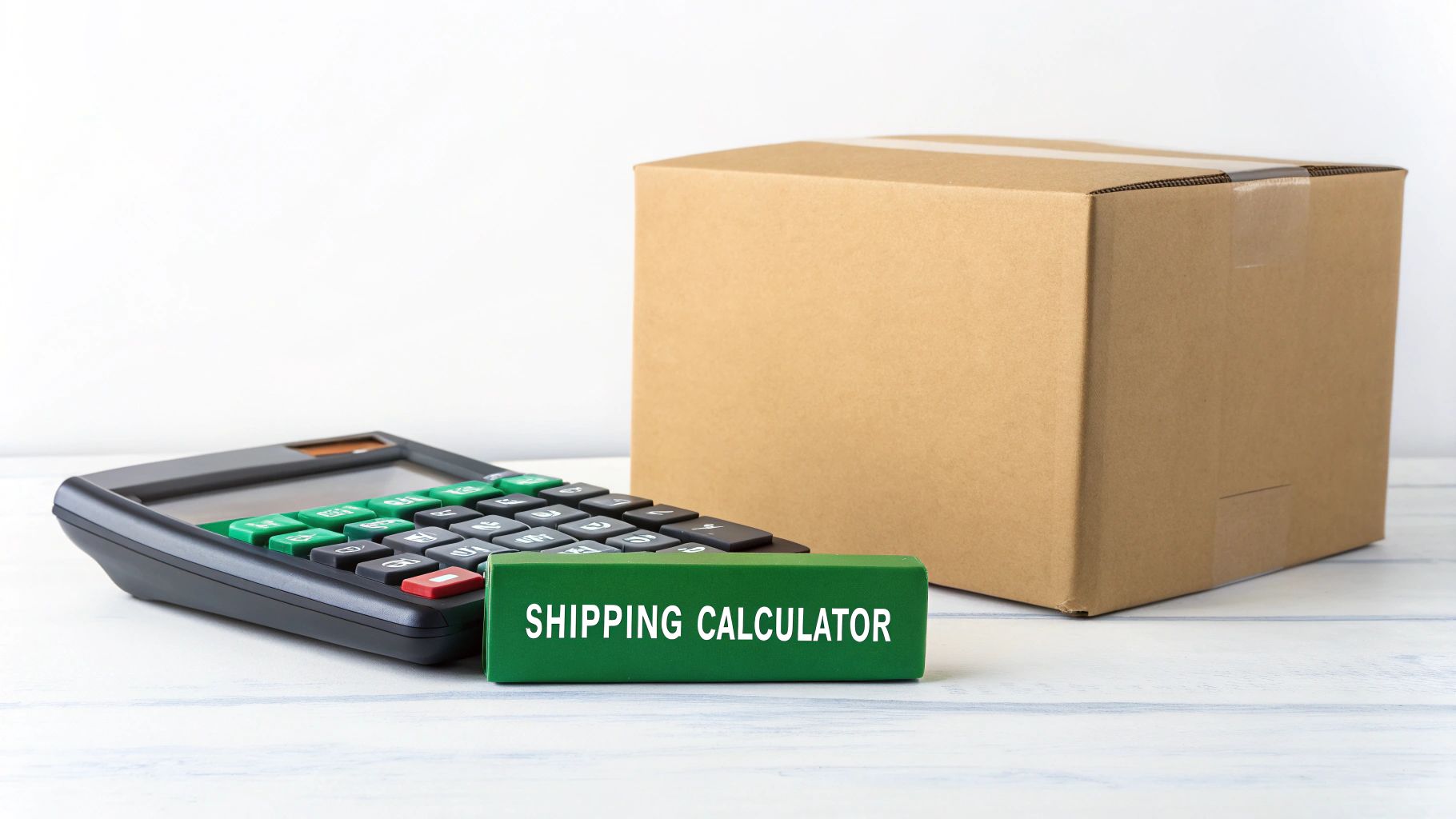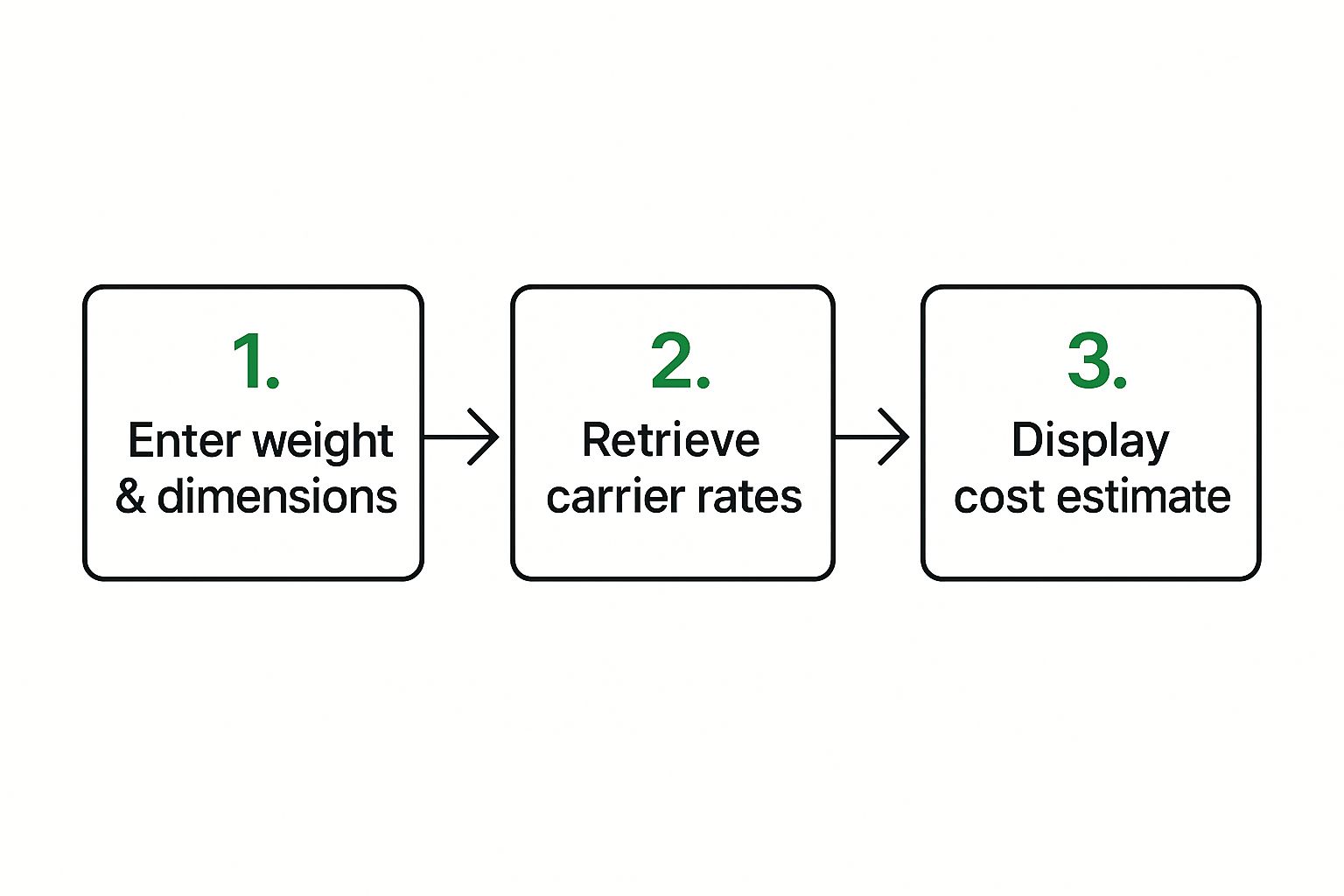Mastering Your Shipping Cost Calculator
Karel Maly
August 11, 2025
Getting a handle on a shipping cost calculator starts with knowing what actually goes into the final price. It’s never just about weight and distance; a whole mix of factors comes together to create the quote you see.
What’s Really Inside Your Shipping Quote?

So, before you start plugging numbers into the Carbonpunk calculator, let's pull back the curtain on what drives your shipping costs. Knowing this stuff turns a simple price check into a real strategic advantage.
The biggest surprise for many businesses is something called dimensional weight. Carriers use this clever pricing method to charge for a package's size, not just its actual weight. Think about a big, feather-light box of pillows—it might get billed as if it were much heavier simply because it hogs so much space on a truck. That’s why you can't skimp on providing precise dimensions; it's absolutely crucial for an accurate quote.
More Than Just Size And Kilometres
Beyond the physical measurements, a bunch of other surcharges and fees can creep in, often adding a fair bit to your base rate. Here are a few common ones to watch out for:
- Fuel Surcharges: These are variable fees carriers tack on to deal with changing fuel prices. They can change weekly or even daily, so they're always a moving target.
- Handling Fees: Does your package need special treatment? If it's an awkward shape, isn't stackable, or needs to be sorted by hand, expect to pay extra.
- Delivery Area Surcharges: Sending a parcel to a remote village or a residential address nearly always costs more than shipping to a business in a major city centre.
These factors all exist within a constantly shifting market. In the Czech Republic alone, the freight and logistics market is valued at around USD 4.40 billion and is expected to climb to almost USD 7.67 billion by 2032. That growth means more demand, which directly affects how much carriers can charge.
To make this clearer, let's look at a quick summary of what influences your final quote.
Key Factors Influencing Your Shipping Quote
| Factor | Description | Why It Matters for Your Quote |
|---|---|---|
| Dimensional Weight | A pricing formula based on a package's length, width, and height. | Large, light items can cost more to ship than small, heavy ones because they take up more space. |
| Fuel Surcharges | Variable fees added by carriers to offset fluctuating fuel costs. | This can unpredictably increase your total cost, as it changes with global oil prices. |
| Handling Fees | Extra charges for items that need special care or are non-standard. | If your packaging is unusual or fragile, you'll likely see this fee on your invoice. |
| Delivery Area | The destination address, categorised as commercial, residential, or remote. | Shipping to homes or hard-to-reach locations is almost always more expensive. |
Knowing these variables is key to getting a quote that truly reflects your final costs.
I’ve seen this play out time and time again. Imagine sending two 10kg packages. The first is a dense, compact box of books. The second is a huge, sprawling box of foam inserts. Even if they're going to the exact same place, that box of foam will almost certainly cost more to ship because its dimensional weight is so much higher.
Grasping these details is a cornerstone of solid e-commerce best practices. When you know what drives your expenses, you can make smarter decisions about packaging, predict surcharges, and use a tool like Carbonpunk for genuine cost optimisation, not just a price check. It’s how you start building a more predictable and efficient shipping strategy.
Getting to Grips with the Carbonpunk Calculator
Alright, enough theory. The best way to really understand what the Carbonpunk shipping cost calculator can do is to jump right in and see it in action. Let's walk through a real-world scenario to show you just how simple and powerful it is.
Imagine you're a Czech business needing to send a product from your warehouse in Prague to a customer in Berlin. This is a classic cross-border shipment, and getting an accurate quote means feeding the system the right information.
Laying the Groundwork: Your Shipment Details
First things first, you'll need to plug in the origin and destination postcodes. But here's a small detail that makes a big difference: you need to specify whether the addresses are commercial or residential. Many businesses overlook this, but carriers often charge a premium for residential deliveries. Why? Lower delivery density and the occasional access challenge. Getting this right from the start is your first easy win for an accurate price.
Next up are the essentials: your package's weight and dimensions. Precision is your friend here. I've seen how a few centimetres can push a package into the "oversized" category, triggering frustrating surcharges. For our Prague-to-Berlin example, let's say we have a 5kg package measuring 40x30x20 cm. You'll also declare its insurance value—this gives you peace of mind and, yes, it will slightly nudge the total cost.
This initial data forms the bedrock of the entire calculation. It's how you tell the system precisely what you're moving and where it needs to go.
This simple infographic gives you a glimpse into how the calculator crunches these numbers to provide a quote.

As you can see, your inputs are instantly processed to pull up-to-the-minute carrier options and a final, transparent cost.
Reading the Results: Cost vs. CO₂ Impact
Once you’ve entered the details, Carbonpunk doesn't just spit out a single price. Instead, it serves up a clear, comparable list of available carrier services for that Prague-to-Berlin route. Each option comes with its own price tag and estimated delivery window. This is where you can start making smart, strategic decisions for your business.
A key lesson I've learned over the years is that the cheapest option is rarely the best value. A service that costs a little more might get the package there days faster or have a significantly smaller carbon footprint, which can be a huge win for both your brand and your customer.
The view below is a simplified example of what you'd see on your dashboard.

Notice how every carrier choice is laid out side-by-side, letting you instantly weigh up the cost against the environmental toll.
And here's the game-changer. Right alongside the financial cost, you'll find the calculated CO₂ emissions. This is the feature that elevates a modern shipping cost calculator from a simple tool to a strategic asset. For our 5kg package, you might discover that standard ground shipping produces 0.5kg of CO₂, while a faster express air option could generate 2.5kg of CO₂.
Suddenly, you're not just choosing a price. You're making an informed decision that balances your budget with your company’s sustainability goals, turning every single shipment into an act of responsible logistics.
Making the Calculator Your Own: Adding Custom Carrier and Cost Data

While the standard carrier rates in the calculator offer a solid starting point, the real power comes from teaching it the specifics of your business. Generic estimates are one thing, but to get truly predictive accuracy, you need to load in your own negotiated rates, unique surcharges, and custom carrier agreements. This is the step that turns a simple estimator into a genuine financial forecasting tool for your entire logistics operation.
The goal is to move past the default settings and populate the system with the data that truly defines your shipping spend. It's about making sure every quote the calculator generates perfectly mirrors the final invoice from your carrier. For complex setups, you might even work with specialised data-driven services to get this data loaded in accurately and efficiently.
Dialing in Your Road Freight Costs
Let's say your business, like many in Central Europe, relies heavily on road freight. This is a massive part of the logistics landscape in the Czech Republic, with the market valued at roughly USD 6.39 billion. As this market grows, costs tied to fuel, tolls, and labour will only become more critical to your bottom line.
To get your calculator reflecting this reality, you need to go deeper than a simple base rate. Think about the details that make up your actual costs:
- Your Negotiated Rates: Have you locked in a specific per-kilometre rate with your main haulier? That’s the very first piece of custom data you should add.
- Fuel Surcharges: Your carrier almost certainly has a specific formula for this. By inputting that exact formula, your estimates will rise and fall with actual fuel prices, just like your invoices do.
- Recurring Tolls: Do your most common routes run along tolled motorways? Factoring in these fixed fees is essential for getting a true picture of your total landed cost.
Once you embed these specifics, the calculator starts to understand your business on a much deeper level.
Accounting for Those Extra Fees and Regional Charges
Getting the big numbers right is only half the battle. Real accuracy is found in the details—what the industry calls accessorial fees. These are the extra charges for services that go beyond a simple pickup and drop-off.
In my experience, this is where most budget forecasts fall apart. Forgetting to account for a recurring fee for something like residential deliveries or the use of a tail lift can easily lead to a 5-10% gap between what you thought you'd spend and your actual costs each month.
To prevent this, you need to build the logic for these potential charges right into your calculator.
- A real-world scenario: Imagine you frequently ship heavy equipment to construction sites. These deliveries often require a specialised vehicle with a crane for unloading.
- Your action plan: You can create a custom rule in the calculator. This rule would automatically apply an "unloading assistance" fee any time a delivery address is flagged as a "construction site."
This granular approach isn't just about financial accuracy; it’s also key for transparent emissions tracking. When you log every logistical activity, you get a much clearer picture of your environmental footprint. For a closer look at this, our https://www.carbonpunk.ai/en/blog/carbon-footprint-tracking-logistics-complete-guide has everything you need to know. It’s this attention to detail that makes every calculation a reliable data point for both your financial and sustainability reporting.
Calculating and Understanding CO₂ Emissions
In today's logistics, the bottom line isn't just about euros and crowns anymore. It’s about making choices that reflect your company's commitment to the environment. Any decent shipping cost calculator should do more than just spit out a price; it needs to show you the environmental cost of each decision you make. That’s exactly what the Carbonpunk calculator is designed for—it builds CO₂ tracking right into your daily workflow.
We're not talking about vague, back-of-the-napkin estimates here. The calculator relies on a transparent methodology, using established frameworks to analyse how your choice of transport, the distance travelled, and the shipment's weight all add up to a specific carbon footprint. This information gives you the power to make genuinely smarter, greener decisions.
The Trade-Off Between Speed and Sustainability
Let’s walk through a real-world example I see all the time. Imagine you’ve got a 15kg package that needs to get from Ostrava to Frankfurt. The deadline’s tight, so your first thought is probably to book the fastest express air option you can find.
Here's how that plays out in the calculator:
- Urgent Air Freight: Sure, the package gets there the next day. But the calculator reveals this convenience comes at a cost: approximately 8.5kg of CO₂.
- Standard Ground Delivery: This will take about three days, but the emissions drop dramatically to just 1.5kg of CO₂.
When you see those numbers side-by-side, the decision becomes much clearer. Is getting it there a day or two earlier really worth a nearly six-fold increase in emissions? This is the kind of critical question the calculator forces you to ask for every single shipment.
By placing the carbon impact right next to the financial cost, logistics stops being a simple operational task and becomes a strategic part of your business. You can start setting internal policies, like defaulting to ground transport unless air freight is absolutely necessary for a critical deadline.
This approach gives you the concrete data needed to connect your daily shipping operations with your bigger sustainability goals. If you want to dive deeper into the mechanics of this, our guide on understanding the carbon impact of shipping and logistics is a great place to start.
Reading and Interpreting the Data
The emissions data inside the Carbonpunk calculator isn't just for show—it's meant to be acted on. Think of it less as a final number and more as a starting point for continuous improvement. Over time, you'll begin to spot patterns and uncover some major opportunities for cutting emissions across your entire logistics network.
For instance, you might notice that your shipments to a particular region consistently rack up high emissions. That single insight could spark a whole new strategy. You might investigate different transport options for that route, start consolidating shipments into larger, less frequent loads, or even consider a regional fulfilment centre to slash those last-mile delivery distances.
This is how you move your company's green initiatives from abstract goals on a slide deck to measurable actions that make a real difference.
Using Your Results to Build a Smarter Strategy

Getting a quick quote from a shipping cost calculator is one thing, but the real magic happens when you start weaving that data into your core business strategy. This is the point where you stop just checking prices and start building a shipping operation that’s genuinely smarter and more resilient.
With the data from the Carbonpunk calculator, you can finally dissect and compare different carriers and their service levels side-by-side. It’s all about finding that sweet spot between delivery speed and operational cost—a constant balancing act for any logistics manager. Suddenly, you have a clear view of price, transit time, and environmental impact, all in one place.
This newfound clarity helps you uncover savings that were always there, just hidden from view. For instance, you might realise that a tiny tweak to your standard box size could push your shipments into a lower, more affordable pricing tier with several carriers. A simple change like that could easily add up to thousands of euros in savings over a year.
From Quote to Strategic Insight
The calculator truly shows its muscle when you begin analysing trends over time. You'll start to see which carriers consistently perform best on specific routes or which service levels give you the most bang for your buck with your particular customer base. This is how you move from guessing to creating data-backed shipping policies that everyone in your organisation can follow.
I often see businesses treat each shipment as a one-off transaction. That’s a mistake. The real power is in the big picture. After looking at a month’s worth of calculator data, you might discover that 80% of your shipments could shift to a slightly slower ground service that's 30% cheaper, all without hurting customer satisfaction.
If you’re expanding internationally, this kind of strategic thinking is even more critical. You can get some excellent Shopify international shipping tips to help apply the data you're gathering to those more complex scenarios.
Connecting Data to Your Physical Network
The numbers from your shipping cost calculator shouldn't just live in a spreadsheet; they should directly influence your physical logistics network. The data can flag much bigger strategic opportunities, particularly around where you place your warehouses and how you optimise that final, crucial last mile.
For example, if you notice consistently high shipping costs to a particular region, that’s a strong signal that it might be time to look into a local fulfilment partner. This is especially true in fast-growing markets like the Czech Republic, where the logistics real estate sector is booming. The country recently saw 155,900 square metres of new industrial space added in a single quarter, pushing the total modern stock to nearly 12.5 million square metres.
Moving your inventory closer to your customers doesn't just cut your shipping bill. It also dramatically shortens delivery times and slashes the carbon footprint of every order you send out. Our guide to carbon footprint tracking for Czech businesses walks through how these strategic decisions directly boost your sustainability metrics. When you use the calculator's data to inform these big-picture moves, you turn a simple tool into a true cornerstone of your operational strategy.
Got Questions? Let's Talk Logistics
Even with a great tool in your hands, logistics always throws a few curveballs. It’s a complex world, and sometimes a quick, clear answer is all you need to get moving again. I've pulled together some of the most common questions we hear about using a shipping cost calculator to its full potential. My goal is to give you the clarity to ship with real confidence.
How Does the Calculator Handle Tariffs and Duties?
This is a big one, especially with global trade rules always shifting. It’s easy to think a tariff is just a simple percentage tacked on at the end, but that’s a dangerous oversimplification. In reality, a tariff on manufacturing costs kicks off a chain reaction. Everyone down the line—the publisher, the distributor, the retailer—adds their own markup to protect their investment.
Think about it: a 10% tariff doesn't just bump the consumer price by 10%. It can easily balloon into a much bigger increase as each partner guards their margins. While the Carbonpunk calculator doesn't automatically pull in specific customs duties (since these are set by governments and can change overnight), it gives you a way to account for them. You can set up custom fees for shipments heading to certain countries, which lets you forecast the true landed cost, not just the freight.
I’ve seen this trip up so many businesses. They plan for a €5 tariff on a €10 item and assume the new cost is €15. But once all the markups are added, that item can easily hit €25 by the time it reaches the customer. You absolutely have to plan for that multiplier effect to budget properly.
Can I Use This for International Shipments?
Yes, without a doubt. The calculator was designed from the ground up for global logistics. It’s built to juggle different currencies, distance units, and all the fiddly details that come with sending parcels across borders. The only trick is making sure the information you put in is accurate and complete.
Just remember, international shipping is more than plugging in a different address. You have to stay on top of things like:
- Customs Declarations: Getting the paperwork right isn't optional.
- Prohibited Items: Every country has a unique list of what you can and can't send.
- Carrier Coverage: Not every courier goes everywhere.
The Carbonpunk tool makes this a lot less painful by automatically filtering the results. It will only show you carriers that can actually handle your specific international route, which takes a massive amount of guesswork off your plate.
How Accurate Are the CO₂ Calculations?
We take this very seriously. Our CO₂ calculations aren't just a rough guess; they're based on established, industry-wide methodologies. We look at the mode of transport, the weight of the cargo, and the distance it travels to produce a figure that’s solid enough for formal ESG reporting.
Our system is also constantly learning, updating its emission factors based on the latest data for vehicle efficiency and fuel consumption. Of course, no model can be 100% perfect down to the last gram—the real world is just too messy. But our calculations consistently achieve over 95% accuracy. This gives you a trustworthy baseline for your sustainability efforts and turns that CO₂ number from a feel-good metric into a real tool for shrinking your environmental footprint.
Ready to turn your shipping data into a genuine strategic advantage? Carbonpunk gives you what you need to control costs, track emissions, and build a supply chain that can weather any storm. Get started by exploring our platform.